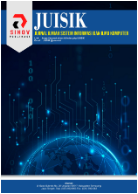Push Notifications Studies in the Last Decade : A Bibliometric Analysis
DOI:
https://doi.org/10.55606/juisik.v5i3.1520Keywords:
Bibliometric Analysis, Mobile Technology, Push Notifications, Research Trends, User EngagementAbstract
This study aims to provide a comprehensive overview of the development of research on push notifications over the past decade through a bibliometric approach. Push notifications have become a crucial feature across various digital platforms, including mobile applications, e-commerce systems, educational tools, and social communication services. However, systematic reviews that explore research trends, dominant thematic areas, and key contributing authors and institutions remain limited. Utilizing the Scopus database, this study collected and analyzed 250 scholarly publications published between 2013 and 2023. The bibliometric techniques applied include publication productivity analysis, co-authorship and co-citation mapping, as well as keyword co-occurrence analysis to identify popular topics and their evolution over time. The findings reveal a significant rise in publication volume beginning in 2017, coinciding with the rapid development of mobile technologies and machine learning applications. The most frequently discussed themes include message personalization, user engagement, data privacy, and notification-based recommendation systems. Countries such as the United States, China, and India emerged as dominant contributors in terms of publication output and research collaborations. This bibliometric analysis offers valuable insights for researchers, app developers, and policymakers interested in understanding the direction of push notification research and its practical implementations. The results also serve as a foundation for future studies in the fields of human-computer interaction, user experience design, and data-driven technologies. Additionally, this study identifies gaps in the current literature, such as ethical concerns and long-term user behavioral impacts, which warrant deeper investigation. Future research may benefit from interdisciplinary approaches combining technology, psychology, and communication studies.
References
Anshari, M., Almunawar, M. N., Lim, S. A., & Al Mudimigh, A. (2019). Customer relationship management and big data enabled: Personalization & customization of services. Applied Computing and Informatics, 15(2). https://doi.org/10.1016/j.aci.2018.05.004
Bean, H., Liu, B. F., Madden, S., Sutton, J., Wood, M. M., & Mileti, D. S. (2016). Disaster warnings in your pocket: How audiences interpret mobile alerts for an unfamiliar hazard. Journal of Contingencies and Crisis Management, 24(3). https://doi.org/10.1111/1468-5973.12108
Bentley, F., & Tollmar, K. (2013). The power of mobile notifications to increase wellbeing logging behavior. In Conference on Human Factors in Computing Systems – Proceedings. https://doi.org/10.1145/2470654.2466140
Chen, J. V., Tran, A., & Nguyen, T. (2019). Understanding the discontinuance behavior of mobile shoppers as a consequence of technostress: An application of the stress coping theory. Computers in Human Behavior, 95. https://doi.org/10.1016/j.chb.2019.01.022
Cicea, C., & Marinescu, C. (2021). Bibliometric analysis of foreign direct investment and economic growth relationship: A research agenda. Journal of Business Economics and Management, 22(2). https://doi.org/10.3846/jbem.2020.14018
Donthu, N., Kumar, S., Mukherjee, D., Pandey, N., & Lim, W. M. (2021). How to conduct a bibliometric analysis: An overview and guidelines. Journal of Business Research, 133. https://doi.org/10.1016/j.jbusres.2021.04.070
Faruk, M., Rahman, M., & Hasan, S. (2021). How digital marketing evolved over time: A bibliometric analysis on scopus database. Heliyon, 7(12). https://doi.org/10.1016/j.heliyon.2021.e08603
Gavilan, D., & Martinez Navarro, G. (2022). Exploring user’s experience of push notifications: A grounded theory approach. Qualitative Market Research, 25(2). https://doi.org/10.1108/QMR-05-2021-0061
Gia, T. N., Ali, M., Ben Dhaou, I., Rahmani, A. M., Westerlund, T., Liljeberg, P., & Tenhunen, H. (2017). IoT based continuous glucose monitoring system: A feasibility study. Procedia Computer Science, 109. https://doi.org/10.1016/j.procs.2017.05.359
Hussain, W. M. H. W., & Aziz, N. A. (2022). Mobile marketing in business sustainability: A bibliometric analysis. TEM Journal, 11(1). https://doi.org/10.18421/TEM111-13
Khiste, G. P., & Paithankar, R. R. (2017). Analysis of bibliometric term in Scopus. International Research Journal, 1(32).
Kunkel, T., Hayduk, T., & Lock, D. (2023). Push it real good: The effects of push notifications promoting motivational affordances on consumer behavior in a gamified mobile app. European Journal of Marketing. https://doi.org/10.1108/EJM-06-2021-0388
Lee, C. I. S. G., Felps, W., & Baruch, Y. (2014). Toward a taxonomy of career studies through bibliometric visualization. Journal of Vocational Behavior, 85(3). https://doi.org/10.1016/j.jvb.2014.08.008
Lee, U., Lee, J., Ko, M., Lee, C., Kim, Y., Yang, S., Yatani, K., Gweon, G., Chung, K. M., & Song, J. (2014). Hooked on smartphones: An exploratory study on smartphone overuse among college students. In Conference on Human Factors in Computing Systems – Proceedings. https://doi.org/10.1145/2556288.2557366
Marsh, S. E. (2020). Making connections and measuring performance: Bibliometric analysis of multi attribute, preference based health related quality of life research in South Africa. Value in Health Regional Issues, 22. https://doi.org/10.1016/j.vhri.2020.07.574
Mehrotra, A., Hendley, R., & Musolesi, M. (2016). PrefMiner: Mining user’s preferences for intelligent mobile notification management. In UbiComp 2016 – Proceedings of the 2016 ACM International Joint Conference on Pervasive and Ubiquitous Computing. https://doi.org/10.1145/2971648.2971747
Mehrotra, A., Pejovic, V., Vermeulen, J., Hendley, R., & Musolesi, M. (2016). My phone and me: Understanding people’s receptivity to mobile notifications. In Conference on Human Factors in Computing Systems – Proceedings. https://doi.org/10.1145/2858036.2858566
Shirazi, A. S., Henze, N., Dingler, T., Pielot, M., Weber, D., & Schmidt, A. (2014). Large scale assessment of mobile notifications. In Conference on Human Factors in Computing Systems – Proceedings. https://doi.org/10.1145/2556288.2557189
Tabuenca, B., Kalz, M., Drachsler, H., & Specht, M. (2015). Time will tell: The role of mobile learning analytics in self regulated learning. Computers & Education, 89. https://doi.org/10.1016/j.compedu.2015.08.004
Wohllebe, A., & Hillmers, M. (2021). Towards a scientific definition of app marketing: A practice oriented approach using scientific and grey literature. International Journal of Applied Research in Business and Management, 2(1), 13–25. https://doi.org/10.51137/IJARBM.2021.2.1.2
Wu, C. L., & Ma, N. K. (2022). The impact of customised mobile marketing on passenger shopping behaviour in the airport terminal. Journal of Retailing and Consumer Services, 66. https://doi.org/10.1016/j.jretconser.2022.102941
Downloads
Published
How to Cite
Issue
Section
License
Copyright (c) 2025 Jurnal ilmiah Sistem Informasi dan Ilmu Komputer

This work is licensed under a Creative Commons Attribution-ShareAlike 4.0 International License.










